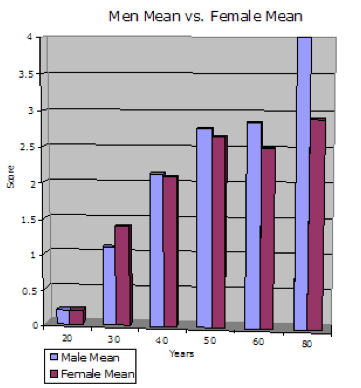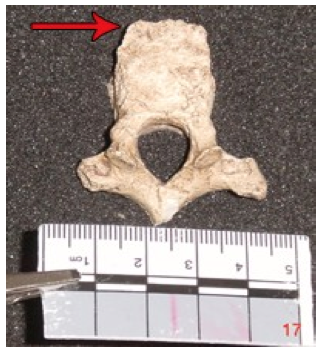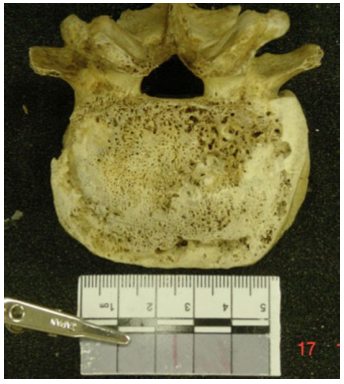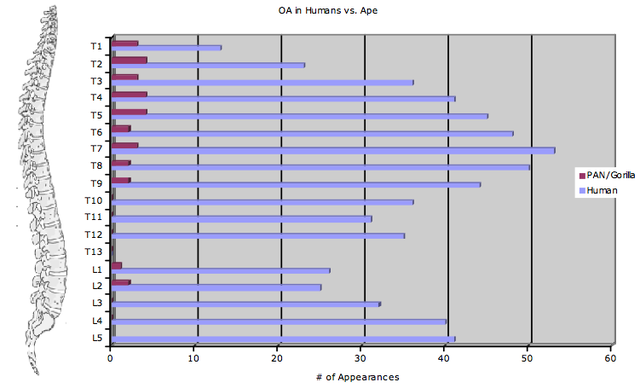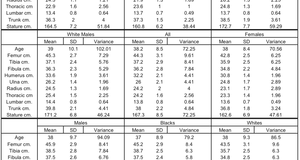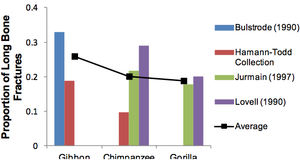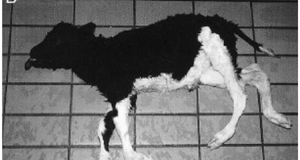From Discussions VOL. 4 NO. 1The Natural History of OsteoarthritisGender and OA in HumansThe specimens were examined to see if gender played a role in OA. Results indicated that men had more extensive OA than females (See Fig-5). The total male population consisted of forty-six specimens, and the total female population consisted of forty-one specimens. Gender differences were examined by taking the mean severity scores per decade of the male population versus female population. At age 20 both males and females had the same severity average, 0.2. At age 30 the females scored 1.4 and males 1.1. This gave the female population the lead with a differential of 0.3. At ages 40, 50, and 60, the male population exhibits higher severity scores, and by the 9th decade of life the average severity score for the males is 4.0, females 2.9. At 80 yearsold this yielded a significant differential of 1.1 (See-Fig-5). Figure 5 shows the male average severity score versus the female average severity score per decade. The male population exhibits more OA than the female population in every group except 30.
OA in Australopithecus "Lucy" (A.L.288-1) A cast of the 3.2 million year-old Australopithecus "Lucy" was examined for signs of OA in the same manner noted above. Lucy exhibited osteophyte formation at the T10 element projecting superiorly from the vertebral body. An additional thoracic vertebra was present with slight osteophyte formation: the exact location of this thoracic vertebra in the column is unknown (Johanson 1982). Figure 6 shows the cast of Lucy with lipping. Figure 6: This is a superior view of the specimen "Lucy." The red arrow is pointing to superior lipping present medially on the specimen‟s superior vertebral body.
OA in Gorillas and ChimpanzeesThe chimp and gorilla sample consisted of 24 specimens which were examined for OA in the same fashion as the human sample. After studying twelve gorillas (Gorilla) and twelve chimpanzees (Pan) it was obvious that the African apes do not demonstrate human-like patterns of OA. Indeed, the ape pattern differs dramatically from that in the human sample. From the twelve Gorillas examined three (25%) of the twelve showed no sign of arthritis, scoring a 0 out of 4. However, three (25%) of the twelve did show OA scoring a 2. Half the gorillas, six (50%) out of twelve, showed minimal arthritis, scoring a 1.Not one gorilla exhibited enough OA to score a 3 or 4. Thus, the total mean severity score among the gorillas was 0.54 out of 4.0. Of the chimps, one (8%) out of twelve displayed minimal arthritis scoring a 1; the other eleven specimens showed no sign of OA. This yielded the chimpanzees a mean severity score of 0.08 out of 4.0. These findings identify the Lowland Gorilla as the ape most susceptible to arthritis, yet the severity remains extremely low, not even reaching 1.0. After differentiating the chimp and gorilla sample for gender, results indicated that among the gorillas, both males and females had equal mean severity scores of 1.0. However there was a difference between male and female chimps. The male chimps averaged a severity score of 0.2 while the female chimps exhibited no arthritic development averaging a 0. The apes were seriated for age by dental wear, but no correlation between age and arthritic development was found. The additional nonhuman primates, orangutans, gibbons, and baboons were each examined, but the sample sizes were small and no OA was noted. Discal Infection in Chimpanzees and GorillasWhile very little arthritis was seen in the nonhuman primate collection, it became apparent that many of these apes suffered from a problem other than OA. A large portion of the chimp and gorilla sample exhibited intradiscal infections, seven out of twelve (58%) gorillas, and five out of twelve (42%) chimpanzees. See (Fig-7) for illustration of an intradiscal infection in one of the examined gorillas. Figure 7 shows the inferior view of an intradiscal infection on the L1 element of a female gorilla.
OA in Apes vs. HumansIt is difficult to gauge the distribution of OA from the ape sample, because little was present. There were distinct differences between the arthritic distributions in humans and apes. The frequency in which arthritis appeared in the gorillas and chimpanzees was predominantly concentrated from T1-T9. At T2, T4, and T5 the arthritis reaches its peak, appearing only four times. From T10-T13 there is no arthritis present. At L1, L2 it appears only 1-2 times. The highest frequency of arthritic development in the ape is located in the portion of the spine that is adjacent to the highly flexible cervical spine, as opposed to the human where the high frequency of arthritic development is located at the midthorax. Figure 8 compares the distribution and frequency of OA in chimpanzee and gorilla sample to that of the human sample. Figure 8
DISCUSSIONThis study sought to compare the nature of the flexible human spine to that of the inflexible ape spinal column in relation to OA. The humans exhibited dramatically greater numbers and a more advanced arthritis than the apes. Not a single ape demonstrated enough arthritic damage to warrant a 3 or 4 severity rating. This data indicates that it is the biomechanical loading of the uniquely curved human spine that results in OA. Given that OA is seen in Lucy‟s mid-thoracic column, the evidence indicates that OA has been a problem among the bipeds over the ages. Plotting arthritis in relation to age signifies that OA is age-related. Spondylosis begins to appear in its minimal form around age 20 and continues to increase in frequency and severity with time. The increase in the incidence is attributed to the increased wear on the vertebrae over time. Averaging scores among gender and race attributes OA to be more common and severe in males likely due to activity. This study rendered numerous results proving the role and type of movement in relation to spondylosis. However, the nonhuman primate sample revealed numerous manifestations of infections, thus indicating that the lack of mobility in the vertebral column may predispose one to infection. The intradiscal infection may arise from the lack of adequate perfusion to the intervertebral disc. This comparative study supports the fact that our evolutionarily selected highly movable spine has disposed the human to spinal OA as a byproduct of locomotion. Although OA will likely develop in all humans with time, our highly mobile spine has decreased a predisposition to the intradiscal infections seen in the African apes. AcknowledgementsI would like to thank Bruce Latimer, Lyman Jellema, and the rest of the staff at the CMNH for all their patience. I would also like to thank the Biology department at Case Western Reserve University, SPUR, and the Howard Hughes Medical Institute for giving me this opportunity. ReferencesAufderheide, A. C., Rodriguez-Martin, C: 1998. The Cambridge Encyclopedia of Human Paleopathology. Cambridge, Cambridge University Press, pp. 93-97. Frankel, H.V., Nordin, M.: 1989. Basic Biomechanics of the Musculoskeletal System. 2nd Ed. Philadelphia, Lea & Febiger, pp. 191. Johanson, D. C., Lovejoy, C. O. Morphology of the Pliocene Partial Hominid Skeleton (A.L. 288-1) From the Hadar Formation, Ethiopia: American Journal of Physical Anthropology. A Wistar Institute Press Journal. 1982: pp. 403. Latimer, B., Ward, C.: 1993. The Nariokotome Homo Erectus Skeleton. Cambridge, The Belnap Press of Harvard University Press. Chapter 12, pp. 266-293. Schmorl, G.: Die Pathogenese der Juvenilis Kyphose. Fortschr Geb Rontgenstr 41: 359-383, 1930. Suggested Reading from Inquiries Journal
Inquiries Journal provides undergraduate and graduate students around the world a platform for the wide dissemination of academic work over a range of core disciplines. Representing the work of students from hundreds of institutions around the globe, Inquiries Journal's large database of academic articles is completely free. Learn more | Blog | Submit Latest in Health Science |

